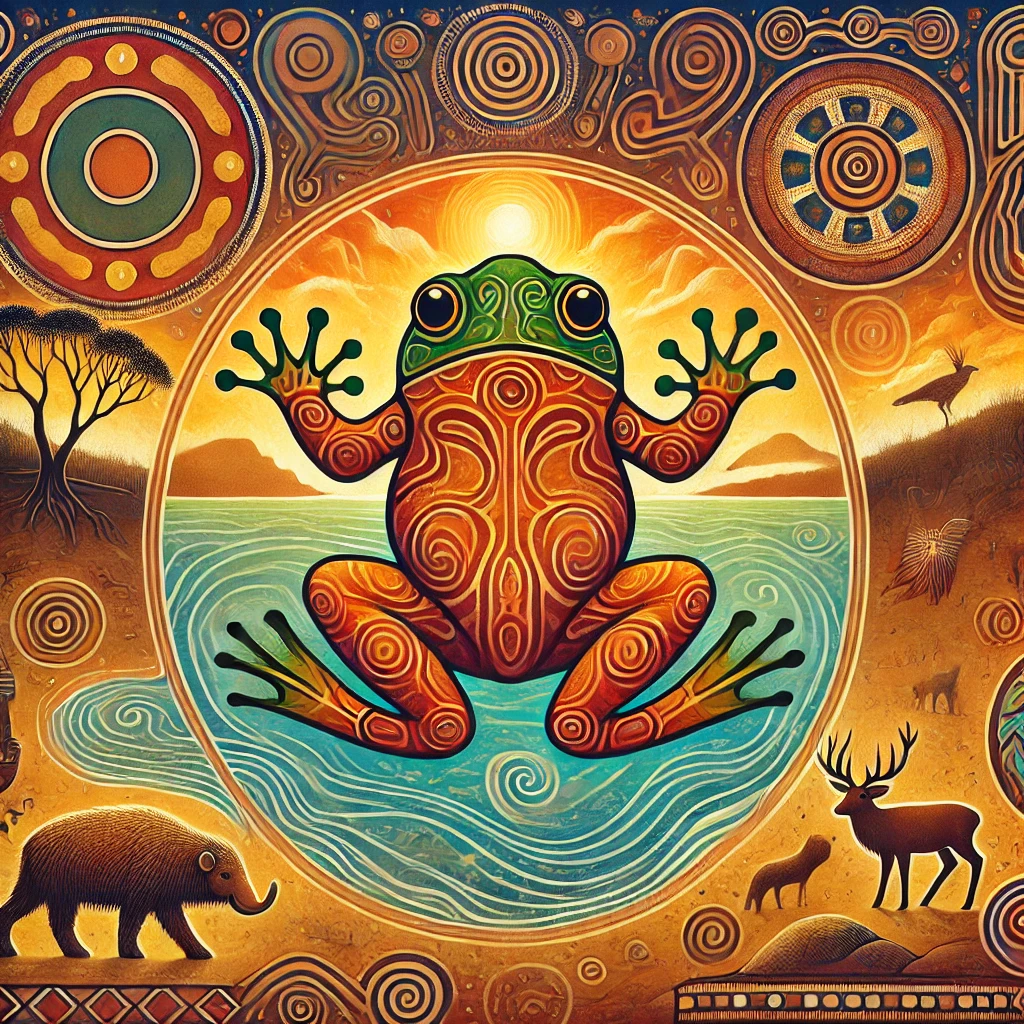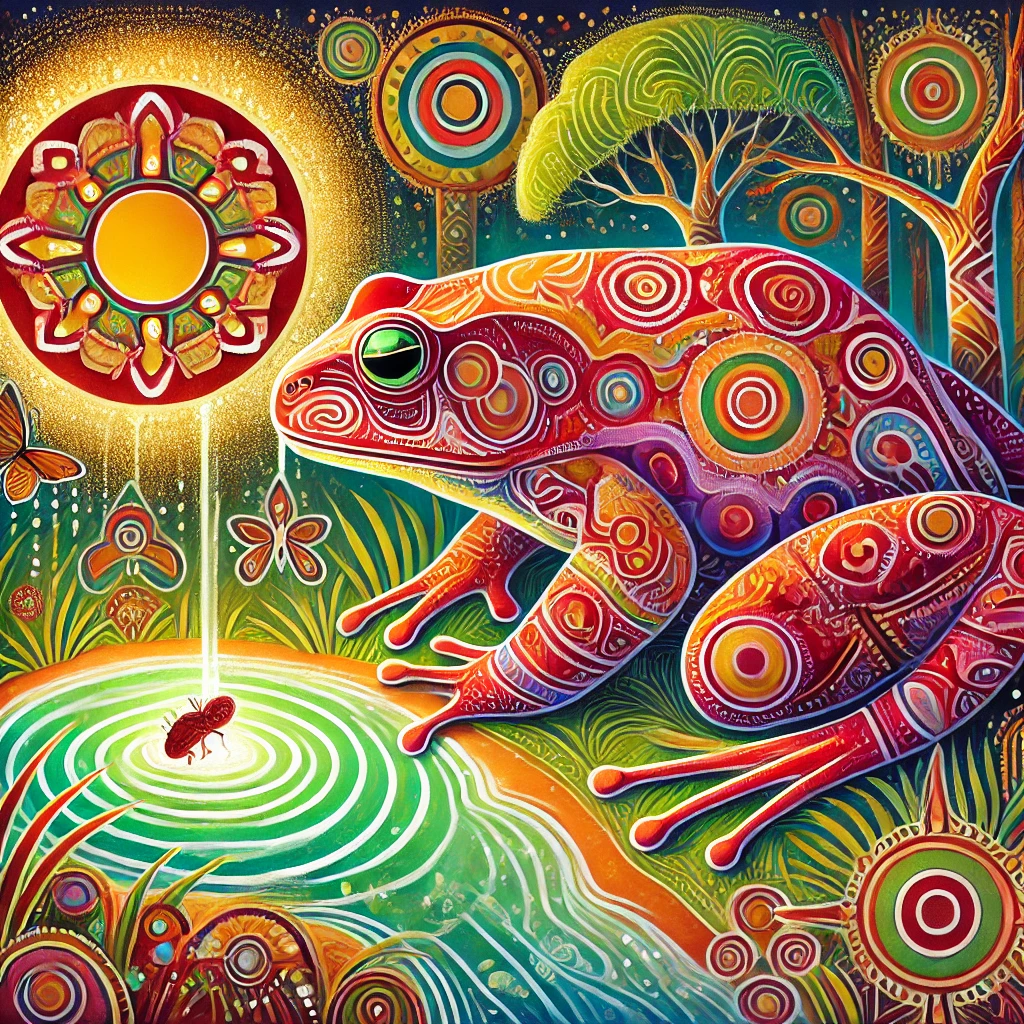Aboriginal folklore is full of captivating stories that highlight the connection between people and nature. One such tale revolves around Tiddalik, the legendary frog whose unique actions shape the world around him.




In the story, Tiddalik drinks all the water, causing the land to dry up. This myth not only explains natural phenomena but also teaches important lessons about balance and community.




Delving into Tiddalik’s story gives me a deeper appreciation for the rich traditions and wisdom embedded in Aboriginal culture, showcasing the enduring power of these ancient narratives.
The Legend Of Tiddalik
In Aboriginal folklore, Tiddalik stands as a central figure in a renowned creation story. Tiddalik, depicted as a colossal frog, woke one morning with an insatiable thirst. He drank all available fresh water from creeks, rivers, and lakes, causing severe drought and threatening the lives of other animals and plants.
To resolve this crisis, the other animals, led by wise creatures such as the owl and wombat, devised a strategy to make Tiddalik laugh. If Tiddalik laughed, he would release the water from his belly. Various animals attempted to amuse him:
- Kookaburra: Performed humorous calls.
- Kangaroo: Executed playful jumps.
- Koala: Made gentle, amusing movements.
- Others: Included diverse species each contributing unique efforts.
Despite several failed attempts, Nabunum the eel, or sometimes the Snake, succeeded by tying himself into comical shapes or becoming twisted into a knot. Tiddalik’s laughter released the stored water, replenishing the lakes, swamps, and rivers.
The Story And Characters

I delve deeper into the narrative of Tiddalik, exploring the central character and the other key figures involved in this Aboriginal folklore.
Tiddalik The Frog
Tiddalik, depicted as a water-holding frog (Ranoidea platycephala or Cyclorana platycephala), absorbs and stores large quantities of water, enabling survival in arid regions. One morning, his insatiable thirst leads him to consume all available fresh water from creeks, rivers, and lakes. This greed triggers a severe drought, threatening the existence of various animals and plants.
Other Key Figures
To resolve the drought, other animals collaborate to make Tiddalik laugh, aiming to release the stored water. Key figures include the wise owl and wombat, who strategise the plan. The kookaburra, kangaroo, and koala attempt to amuse Tiddalik through various antics. Ultimately, Nabunum the eel, or occasionally the Snake, succeeds by tying himself into comical shapes, causing Tiddalik to laugh and restore the water supply.
Symbolism And Themes

- Water and Drought: Tiddalik’s actions highlight the control and distribution of water, a vital resource in the Australian environment. The story underscores water’s importance and the severe consequences of its absence[1][4][5].
- Greedy Behavior: His greed and selfishness represent the dangers of taking more than one needs, harming the entire community[3][4].
- Balance of Nature: The narrative emphasizes the necessity for balance in nature, illustrating how disruption affects all living beings.
Cultural Significance
The story of Tiddalik holds profound cultural meaning within Aboriginal communities.
- Origin and Attribution: I found that Tiddalik’s legend originates from the Gunaikurnai people of South Gippsland, Victoria. The narrative also appears in various forms across different Aboriginal tribes throughout Australia.
- Symbolism and Lessons: The Tiddalik story conveys essential lessons about environmental balance, the dangers of excessive consumption, and the importance of community cooperation to restore harmony.
- Ongoing Influence: I observed that Tiddalik’s tale remains relevant today, reinforcing the value of Indigenous traditions and promoting environmental awareness within contemporary Australian society.
Representation In Art And Media
Art And Theatre
Tiddalik’s story inspires various artistic and theatrical expressions. John T Patten crafted artwork and produced a theatre show based on the original Gunnai narrative. The production achieved significant success, running over 60 performances and drawing large audiences. This adaptation highlights the enduring relevance of Tiddalik’s tale and its ability to engage contemporary audiences through visual and performing arts.
Literature And Educational Materials
Tiddalik features prominently in Aboriginal literature and educational resources. Books and storytelling sessions incorporate his legend to teach children about environmental stewardship and community cooperation. These materials ensure that the wisdom embedded in Tiddalik’s story continues to educate and inspire future generations.
Visual Arts
Artists depict Tiddalik in various mediums, including paintings, sculptures, and digital art. These representations often emphasize his immense size and the dramatic impact of his actions on the environment. Visual interpretations help preserve the cultural significance of Tiddalik’s story and make it accessible to a broader audience.
Media Adaptations
Tiddalik appears in documentaries and educational programmes that explore Aboriginal folklore. These media adaptations provide insights into the cultural context of the story and its role in explaining natural phenomena. By featuring Tiddalik, these programmes promote understanding and appreciation of Indigenous Australian traditions.
Community Performances
Local communities celebrate Tiddalik through festivals and cultural events. Performances include traditional dances, songs, and reenactments of the story, fostering a sense of identity and continuity. These events engage both Indigenous and non-Indigenous audiences, promoting cultural exchange and respect.
Contemporary Interpretations
Modern interpretations of Tiddalik integrate contemporary themes such as environmental conservation and sustainability. Artists and storytellers reimagine the tale to address current issues, demonstrating the story’s adaptability and ongoing relevance. These interpretations resonate with today’s audiences, highlighting the timeless nature of Tiddalik’s lessons.
Digital Media
Digital platforms showcase Tiddalik through animations, interactive stories, and social media campaigns. These formats reach a global audience, increasing awareness of Aboriginal folklore. Digital representations ensure that Tiddalik’s story remains vibrant and accessible in the digital age.
Educational Theatre
Educational theatre programs use Tiddalik’s story to teach students about Indigenous cultures and environmental responsibility. Interactive performances encourage participation and deeper understanding, making the legend an effective tool for education. These programs bridge cultural gaps and foster mutual respect among diverse communities.
Artistic Collaborations
Collaborations between Indigenous artists and mainstream creators bring new dimensions to Tiddalik’s story. These partnerships blend traditional and contemporary styles, enriching the narrative and expanding its reach. Artistic collaborations highlight the collaborative spirit inherent in Tiddalik’s tale.
Conclusion
Through diverse artistic and media representations, Tiddalik remains a vital figure in Aboriginal folklore. These adaptations preserve the story’s cultural significance and ensure its relevance for future generations.
Key Takeaways
- Central Figure in Aboriginal Folklore: Tiddalik, the legendary frog, plays a pivotal role in Aboriginal stories, symbolising the delicate balance of nature.
- Lessons on Greed and Consumption: The tale highlights the dangers of excessive consumption and greed, demonstrating their impact on the environment and community.
- Importance of Community Collaboration: The story showcases how collective efforts and cooperation among diverse animals can overcome challenges and restore harmony.
- Cultural Significance: Originating from the Gunaikurnai people, Tiddalik’s legend is shared across various Aboriginal tribes, reflecting its deep-rooted cultural importance.
- Influence on Art and Media: Tiddalik continues to inspire contemporary art, theatre, and educational materials, promoting environmental awareness and the preservation of Indigenous traditions.
Conclusion
Exploring Tiddalik’s story deepened my understanding of Aboriginal traditions and their profound connection to the environment. The tale not only highlights the importance of balance and cooperation but also resonates with contemporary environmental challenges. Embracing these ancient lessons can inspire us to foster community and stewardship in our own lives. Tiddalik remains a powerful symbol of how storytelling preserves cultural wisdom and encourages us to respect nature’s delicate equilibrium.
Frequently Asked Questions
What is the story of Tiddalik in Aboriginal folklore?
Tiddalik is a legendary frog from Aboriginal folklore who drinks all the water in creeks, rivers, and lakes, causing a severe drought. To restore the water supply, other animals collaborate to make Tiddalik laugh, which releases the stored water. This tale explains natural droughts and emphasises the importance of balance and community in nature.
How does the story of Tiddalik explain natural phenomena?
The Tiddalik story uses the frog’s excessive drinking to illustrate the occurrence of droughts. By showing how Tiddalik’s actions lead to water shortages, the myth provides a cultural explanation for natural dry periods, highlighting the need for environmental balance and the interconnectedness of all living things.
What lessons does the Tiddalik tale teach?
Tiddalik’s story imparts lessons about the dangers of greed and selfishness. It emphasises the importance of community cooperation and balance in nature. The tale warns against excessive consumption and shows how collective effort can overcome challenges, promoting environmental stewardship and mutual respect.
Who are the key characters in the Tiddalik story?
Key characters include Tiddalik, the water-drinking frog, and the other animals like the owl, wombat, kookaburra, kangaroo, and koala. Nabunum the eel or the Snake plays a crucial role in making Tiddalik laugh, thereby releasing the stored water and restoring the environment.
What cultural significance does Tiddalik hold for Aboriginal communities?
Tiddalik’s story is deeply rooted in Aboriginal culture, particularly among the Gunaikurnai people of South Gippsland, Victoria. It highlights traditional wisdom and values, reinforces environmental awareness, and serves as an educational tool. The tale fosters cultural pride and preserves Indigenous heritage across various Australian Aboriginal tribes.
How is Tiddalik represented in art and media?
Tiddalik is depicted in various artistic forms, including John T Patten’s artwork and theatrical productions. The story is featured in Aboriginal literature, educational materials, and visual arts. Modern adaptations address themes like environmental conservation, and digital media ensures the tale remains accessible, promoting cultural exchange and respect.
What themes are central to the Tiddalik story?
Central themes include environmental balance, the dangers of excessive consumption, and the importance of community cooperation. The story highlights how selfish actions can disrupt nature and affect all living beings, promoting the idea that harmony and collective effort are essential for sustaining the environment.
How does Tiddalik’s story promote environmental awareness today?
Tiddalik’s tale reinforces the importance of water conservation and environmental stewardship. Contemporary interpretations link the myth to modern issues like climate change and resource management. Educational programmes and media adaptations use the story to teach sustainable practices and encourage respect for natural resources among new generations.
What role does Tiddalik play in Aboriginal educational programs?
In Aboriginal educational programs, Tiddalik’s story is used to teach children about environmental stewardship, community cooperation, and cultural heritage. The narrative bridges cultural gaps, promotes mutual respect, and ensures that traditional wisdom is passed down, fostering a deeper understanding of Indigenous values and ecological responsibility.
How does the Tiddalik legend vary among different Aboriginal tribes?
While the core story of Tiddalik remains consistent, variations exist among different Aboriginal tribes across Australia. Each tribe may feature unique characters, settings, or specific moral lessons tailored to their cultural context. These adaptations reflect the diverse traditions and perspectives within Aboriginal communities, enriching the overall folklore.
Author

Josh Morley holds a Bachelor’s degree in Theology from the Trinity School of Theology and a Diploma in Theology from the Bible College of Wales. His academic journey involved interfaith community projects and supporting international students, experiences that shaped his leadership and reflective skills. Now based in Liverpool, Josh is also the founder of Marketing the Change, a digital agency specializing in web design and marketing.
View all posts





